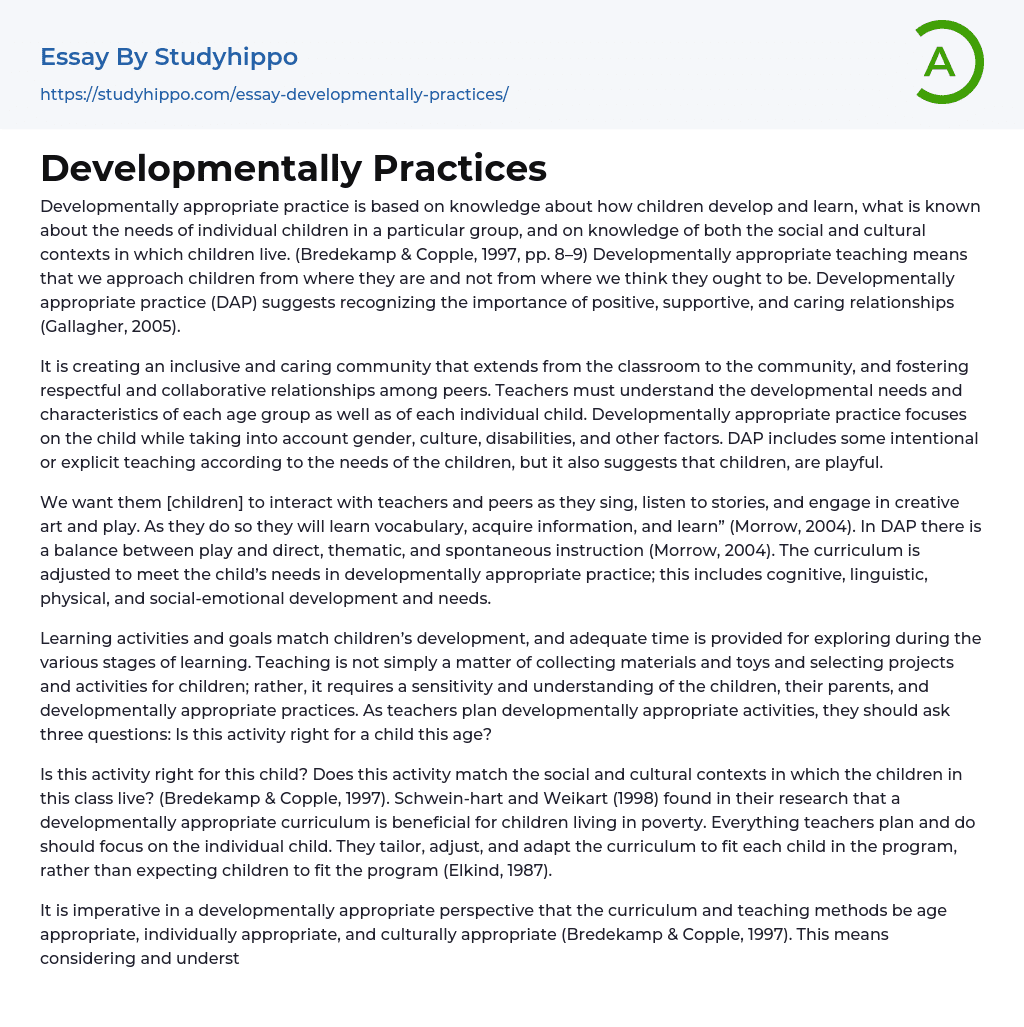Developmentally appropriate practice is based on knowledge about how children develop and learn, what is known about the needs of individual children in a particular group, and on knowledge of both the social and cultural contexts in which children live. (Bredekamp & Copple, 1997, pp. 8–9) Developmentally appropriate teaching means that we approach children from where they are and not from where we think they ought to be. Developmentally appropriate practice (DAP) suggests recognizing the importance of positive, supportive, and caring relationships (Gallagher, 2005).
It is creating an inclusive and caring community that extends from the classroom to the community, and fostering respectful and collaborative relationships among peers. Teachers must understand the developmental needs and characteristics of each age group as well as of each individual child. Developmentally appropriate practice focuses on the child while taking into account
...gender, culture, disabilities, and other factors. DAP includes some intentional or explicit teaching according to the needs of the children, but it also suggests that children, are playful.
We want them [children] to interact with teachers and peers as they sing, listen to stories, and engage in creative art and play. As they do so they will learn vocabulary, acquire information, and learn” (Morrow, 2004). In DAP there is a balance between play and direct, thematic, and spontaneous instruction (Morrow, 2004). The curriculum is adjusted to meet the child’s needs in developmentally appropriate practice; this includes cognitive, linguistic, physical, and social-emotional development and needs.
Learning activities and goals match children’s development, and adequate time is provided for exploring during the various stages of learning. Teaching is not simply a matter of collecting materials and toys and selecting projects and activitie
for children; rather, it requires a sensitivity and understanding of the children, their parents, and developmentally appropriate practices. As teachers plan developmentally appropriate activities, they should ask three questions: Is this activity right for a child this age?
Is this activity right for this child? Does this activity match the social and cultural contexts in which the children in this class live? (Bredekamp & Copple, 1997). Schwein-hart and Weikart (1998) found in their research that a developmentally appropriate curriculum is beneficial for children living in poverty. Everything teachers plan and do should focus on the individual child. They tailor, adjust, and adapt the curriculum to fit each child in the program, rather than expecting children to fit the program (Elkind, 1987).
It is imperative in a developmentally appropriate perspective that the curriculum and teaching methods be age appropriate, individually appropriate, and culturally appropriate (Bredekamp & Copple, 1997). This means considering and understanding similarities within an age group, and also recognizing each child’s individual differences. In a developmentally appropriate classroom, children are allowed to progress at their own rate, and both the curriculum and teaching strategies are relevant for all the children in the classroom.
Thus, a great deal of flexibility is required, but this does not mean a total lack of structure and academics; rather, it means that the structure and academics of the program are based on individual and group needs and current understanding of child development (Raines, 1997). Children should be encouraged to engage fully in each stage of development. Their learning should be a pleasant and fascinating journey, with their motivation for learning emerging from their “natural curiosity and desire to make sense of their
world” (Hart, Burts, & Charlesworth, 1997, p. ).
Teachers, viewed as facilitators, play an active role in helping children to construct their knowledge and understanding (Raines, 1997). Recognizing the diversity in rates of intellectual attainment and mental abilities requires constant accommodation and flexibility on the part of the teacher (Elkind, 1996). Teachers thus need to view the early childhood age range as a continuum rather than as separate grade levels. Playing with a wide selection of equipment allows children to explore and develop confidence and independence skills.
- Academia essays
- Higher Education essays
- Language Learning essays
- Studying Business essays
- Education System essays
- Study essays
- First Day of School essays
- Scholarship essays
- Pedagogy essays
- Curriculum essays
- Coursework essays
- Studying Abroad essays
- Philosophy of Education essays
- Purpose of Education essays
- Brainstorming essays
- Educational Goals essays
- Importance Of College Education essays
- Brown V Board of Education essays
- The Importance Of Higher Education essays
- Online Education Vs Traditional Education essays
- Academic And Career Goals essays
- Academic Integrity essays
- Brown Vs Board Of Education essays
- Distance learning essays
- Technology in Education essays
- Vocabulary essays
- Writing Experience essays
- Importance of Education essays
- Early Childhood Education essays
- Academic Degree essays
- Academic Dishonesty essays
- School Uniform essays
- Academic writing essays
- Cheating essays
- Bachelor's Degree essays
- MBA essays
- College Life essays
- Grade essays
- Diploma essays
- Phonology essays
- Sentence essays
- Filipino Language essays
- Pragmatics essays
- Millennium Development Goals essays
- History Of Education essays
- Graduate School essays
- Middle School essays
- School essays
- Special Education essays
- University essays




